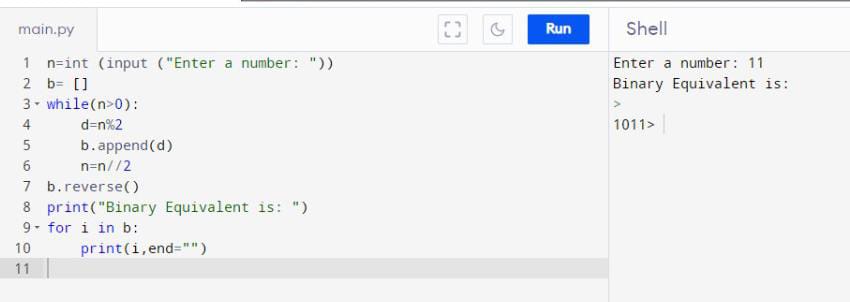Python Decode Binary if You Dont Know Its Binary
In the world of programming, the conversion of Python int to Binary is often necessary to better grasp the working and understanding of the computer. Earlier moving farther, it is necessary to understand the basics. So, allow usa first perceive the meaning of these terms.
Int – Information technology is the integer data type in python. It may exist a positive or negative whole number without a decimal point. In python, the size of the int data type is unlimited.
Binary – It is a numeric system that comprises of solely two digits – 0 and one.
In python there are several ways to convert an int to binary:
- Traditional Method (Without Whatsoever Role)
- Integer To Binary Using Bin() Role
- Using Str.Format() Function
- Integer To Binary Using F-Strings
- Using Format()
Traditional method to Convert Python int to Binary (without any function):
Firstly, dissever the number by ii and add together the residual to a list. And so go along stride 1 till the number is greater than 0. After this, opposite the list. At terminal, print the reversed list.
Source code to Convert Python int to Binary:
n=int (input ("Enter a number: ")) b= [] while(north>0): d=northward%2 b.append(d) northward=n//2 b.reverse() print("Binary Equivalent is: ") for i in b: print(i,stop="") Output:

Explanation:
At showtime, the user will enter a number, which in this case is xi.
The while loop iterates till the number becomes greater than 0.
In each iteration, the digit is divided past 2, and the rest is appended to the list. The list is and then reversed (As done traditionally to convert an integer to binary theoretically) and printed. Every bit a result, we get the binary equivalent of the integer.
Python int to Binary Using bin() office:
It is python's built-in function. It takes integer every bit input and returns its binary representation in string format as output.
Syntax:
bin(num)
Parameters:
num – integer
Note: if num is not an integer, __index()__ method should be implemented to render an integer. One may incur TypeError Exception
Instance 1: Python int to Binary
num1 = 1 num2 = 7 print('The binary equivalent of 1 is:', bin(num1)) print('The binary equivalent of 7 is:', bin(num2)) Output:

Explanation:
Here the variable num1, num2 stores the integer value.
With the use of bin() part, a direct conversion of integer to binary occurs.
0b ways that information technology is a binary string.
Instance two: Python int to Binary
class color: cherry-red = 1 blue = two green = two def __index__(self): return self.crimson + self.blue + cocky.green impress('The binary equivalent of colour is:', bin(color())) Output:

Explanation:
An object of course color is sent to thebin()method.
However, it doesn't raise an error even though the object is not an integer.
This is because of the implementation of __index__()method which returns the sum of colors, which is an integer value. This sum is then passed to the bin() method.
Python int to Binary Using str.format() function:
Information technology is a born function in python available for string formatting. To convert an integer to its binary equivalent, the string representation of type b can be used.
Syntax:
"{0:b}".format(num) Parameters:
num - integer
Example:
num = 5 binary = "{0:b}".format(num) print('Binary equivalent of num is',binary) Output:

Explanation:
In this case, nosotros have used the str.format() function for converting our integer to its binary equivalent (specified past using the blazon b). So, when the number five is passed every bit a parameter, the str.format() role converts it to its binary equivalent.
Python Int to binary using f-strings:
f-strings tin exist used in the version python 3.6 and above. In this, the cord literal is prefixed with f or F.
Syntax:
f"{value}" Parameter:
It converts the parameters enclosed in curly braces {} into cord
Example:
num = 5 b = f'{num:b}' print('Binary equivalent of 5 is',b) Output:

Explanation:
fstring is an improved version for string formatting. When the value is passed, it is converted into binary (denoted past 'b'), and this binary is then converted into string conveniently using the fstring.
Catechumen Python int to Binary Using format():
It is notwithstanding some other inbuilt office available in python. Information technology converts a specific value into a string every bit per the formatting specifications required by the user.
Syntax:
format(value[num, format_spec])
Parameters:
num – integer
Example: Python int to Binary
num = 7 b = format(num, "b") print('Binary of vii is',b) Output:

Explanation:
Format () is a built-in office available in python. Here, we take used information technology to convert the integer value to its binary representation. As a event, when we pass the value seven, it converts it to binary as per our specified format.
Conclusion: Python int to Binary
These are various to convert Integer to Binary in Python. So, when one is doing a program, one should keep in listen the programme'southward needs and constraints and choose the all-time possible fit, every bit it may differ based on requirement and personal preference.
Nonetheless, if you have any doubts or questions, do allow me know in the comment section below. I will try to help y'all as soon every bit possible.
Happy Pythoning!
Source: https://www.pythonpool.com/python-int-to-binary/
0 Response to "Python Decode Binary if You Dont Know Its Binary"
Enregistrer un commentaire